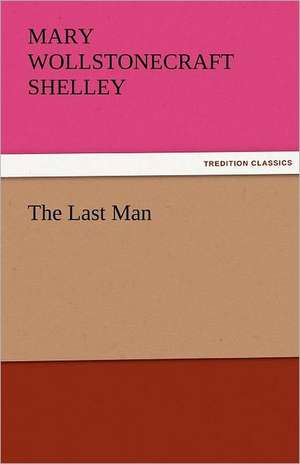The Last Man
Autor Mary Wollstonecraft Shelleyen Limba Engleză Paperback – 30 noi 2011
| Toate formatele și edițiile | Preț | Express |
|---|---|---|
| Paperback (8) | 59.28 lei 3-5 săpt. | |
| CreateSpace Independent Publishing Platform – | 59.28 lei 3-5 săpt. | |
| Oxford University Press – 14 aug 2008 | 65.89 lei 10-16 zile | +26.39 lei 7-13 zile |
| CREATESPACE – | 142.53 lei 3-5 săpt. | |
| – | 208.33 lei 3-5 săpt. | |
| Bottom of the Hill Publishing – 30 iun 2014 | 137.26 lei 6-8 săpt. | |
| – | 176.99 lei 6-8 săpt. | |
| Indoeuropeanpublishing.com – 6 ian 2010 | 189.01 lei 6-8 săpt. | |
| TREDITION CLASSICS – 30 noi 2011 | 264.34 lei 6-8 săpt. | |
| Hardback (1) | 238.50 lei 6-8 săpt. | |
| LIGHTNING SOURCE INC – 29 apr 2007 | 238.50 lei 6-8 săpt. |
Preț: 264.34 lei
Nou
Puncte Express: 397
Preț estimativ în valută:
50.58€ • 52.95$ • 41.85£
50.58€ • 52.95$ • 41.85£
Carte tipărită la comandă
Livrare economică 05-19 aprilie
Preluare comenzi: 021 569.72.76
Specificații
ISBN-13: 9783842486430
ISBN-10: 384248643X
Pagini: 464
Dimensiuni: 129 x 198 x 24 mm
Greutate: 0.45 kg
Editura: TREDITION CLASSICS
ISBN-10: 384248643X
Pagini: 464
Dimensiuni: 129 x 198 x 24 mm
Greutate: 0.45 kg
Editura: TREDITION CLASSICS
Descriere
Descriere de la o altă ediție sau format:
'The last man! I may well describe that solitary being's feelings, feeling myself as the last relic of a beloved race, my companions extinct before me.' Mary Shelley, Journal (May 1824). Best remembered as the author of Frankenstein, Mary Shelley wrote The Last Man eight years later, on returning to England from Italy after her husband's death. It is the twenty-first century, and England is a republic governed by a ruling elite, one of whom, Adrian, Earl of Windsor, has introduced a Cumbrian boy to the circle. This outsider, Lionel Verney, narrates the story, a tale of complicated, tragic love, and of the gradual extermination of the human race by plague. The Last Man also functions as an intriguing roman à clef, for the saintly Adrian is a monument to Percy Bysshe Shelley, and his friend Lord Raymond is a portrait of Byron. The novel offers a vision of the future that expresses a reaction against Romanticism, as Shelley demonstrates the failure of the imagination and of art to redeem her doomed characters. ABOUT THE SERIES: For over 100 years Oxford World's Classics has made available the widest range of literature from around the globe. Each affordable volume reflects Oxford's commitment to scholarship, providing the most accurate text plus a wealth of other valuable features, including expert introductions by leading authorities, helpful notes to clarify the text, up-to-date bibliographies for further study, and much more.
'The last man! I may well describe that solitary being's feelings, feeling myself as the last relic of a beloved race, my companions extinct before me.' Mary Shelley, Journal (May 1824). Best remembered as the author of Frankenstein, Mary Shelley wrote The Last Man eight years later, on returning to England from Italy after her husband's death. It is the twenty-first century, and England is a republic governed by a ruling elite, one of whom, Adrian, Earl of Windsor, has introduced a Cumbrian boy to the circle. This outsider, Lionel Verney, narrates the story, a tale of complicated, tragic love, and of the gradual extermination of the human race by plague. The Last Man also functions as an intriguing roman à clef, for the saintly Adrian is a monument to Percy Bysshe Shelley, and his friend Lord Raymond is a portrait of Byron. The novel offers a vision of the future that expresses a reaction against Romanticism, as Shelley demonstrates the failure of the imagination and of art to redeem her doomed characters. ABOUT THE SERIES: For over 100 years Oxford World's Classics has made available the widest range of literature from around the globe. Each affordable volume reflects Oxford's commitment to scholarship, providing the most accurate text plus a wealth of other valuable features, including expert introductions by leading authorities, helpful notes to clarify the text, up-to-date bibliographies for further study, and much more.
Notă biografică
Mary Wollstonecraft Shelley (1797 - 1851) was an English novelist, short story writer, dramatist, essayist, biographer and travel writer, best known for her Gothic novel Frankenstein: or, The Modern Prometheus (1818). She also edited and promoted the works of her husband, the Romantic poet and philosopher Percy Bysshe Shelley. Her father was the political philosopher William Godwin, and her mother was the philosopher and feminist Mary Wollstonecraft.
